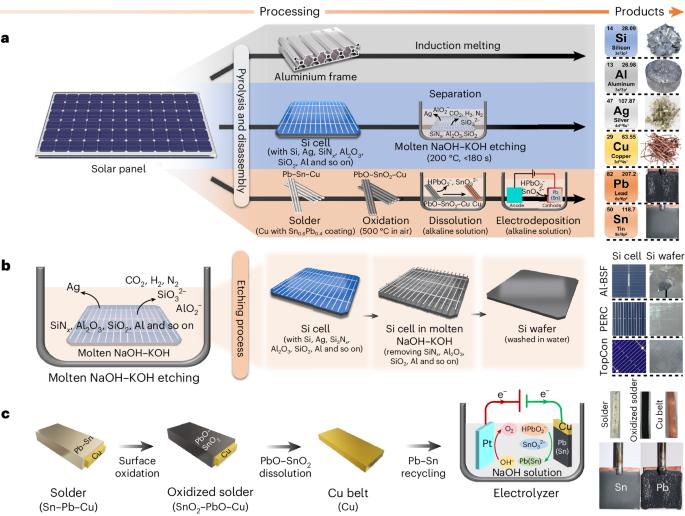通过盐蚀方法回收硅太阳能电池板
IF 25.7
1区 环境科学与生态学
Q1 ENVIRONMENTAL SCIENCES
引用次数: 0
摘要
在向碳中和能源系统过渡的过程中,硅(Si)太阳能电池板的生产和使用量急剧增加。为了减少对环境的影响,迫切需要开发一种高效的回收方法来处理报废的硅太阳能电池板。在此,我们报告了一种简单的盐蚀刻方法,可在不使用有毒矿物酸和不产生二次污染的情况下回收报废硅太阳能电池板中的银和硅。这种蚀刻工艺得益于熔融氢氧化物的高腐蚀性,它通过自上而下的方向与硅晶片表面的 SiNx、SiO2、Al2O3 和 Al 自发发生反应,从而直接将 Ag 从硅晶片中分离出来。蚀刻过程仅需 180 秒,即可从报废硅太阳能电池板中回收 99.0% 的银和 98.0% 的硅。此外,硅太阳能电池板中的铜、铅、锡和铝也通过氧化、碱性浸出和电沉积相结合的方法得到了回收。总之,这项研究提出了一种可持续管理报废硅太阳能电池板的可行方法,为循环经济铺平了道路。硅太阳能电池板是能源转型的核心技术,其生产的蓬勃发展要求对其进行适当的报废管理。在此,作者提出了一种盐蚀方法,能够在不使用有毒试剂的情况下,高效回收报废硅太阳能电池板中的关键材料。本文章由计算机程序翻译,如有差异,请以英文原文为准。

Recycling of silicon solar panels through a salt-etching approach
The production and use of silicon (Si) solar panels is soaring during the transition to a carbon-neutral energy system. To mitigate their environmental footprints, there is an urgent need to develop an efficient recycling method to handle end-of-life Si solar panels. Here we report a simple salt-etching approach to recycle Ag and Si from end-of-life Si solar panels without using toxic mineral acids and generating secondary pollution. The etching process is enabled by the high corrosivity of molten hydroxide that spontaneously reacts with SiNx, SiO2, Al2O3 and Al at the surface of Si wafers through the top-down direction, thereby directly separating Ag from Si wafers. The etching process takes only 180 s to recover >99.0% of Ag and >98.0% of Si from end-of-life Si solar panels. In addition, Cu, Pb, Sn and Al in Si solar panels are also recovered through a combined oxidation, alkaline leaching and electrodeposition approach. Overall, this study presents a viable approach for sustainable management of end-of-life Si solar panels, paving the way to a circular economy. The booming production of silicon solar panels, a core technology in the energy transition, calls for proper end-of-life management. Here the authors propose a salt-etching approach that enables efficient recycling of critical materials from end-of-life silicon solar panels, without the use of toxic reagents.
求助全文
通过发布文献求助,成功后即可免费获取论文全文。
去求助
来源期刊

Nature Sustainability
Energy-Renewable Energy, Sustainability and the Environment
CiteScore
41.90
自引率
1.10%
发文量
159
期刊介绍:
Nature Sustainability aims to facilitate cross-disciplinary dialogues and bring together research fields that contribute to understanding how we organize our lives in a finite world and the impacts of our actions.
Nature Sustainability will not only publish fundamental research but also significant investigations into policies and solutions for ensuring human well-being now and in the future.Its ultimate goal is to address the greatest challenges of our time.
 求助内容:
求助内容: 应助结果提醒方式:
应助结果提醒方式:


